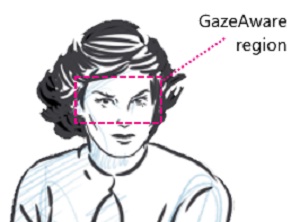Tobii has written a new post (http://tinyurl.com/puh8q2a) about four different ways in which eye-tracking can be used by developers. All of these have been used by Tobii at some point.
Multi-dimensional movement is a way to use a player’s eyes as an additional input; it can give a game character the ability to move in one direction while aiming or interacting with something in another direction. We used this when we played a demonstration of Son of Nor at CES this year (CES Unveiled Prepares Us for Show Floor).
Tobii’s EyeX SDK for Unity was utilised in the Son of Nor demo. The eye-gaze data cannot precisely pinpoint a user’s gaze direction, so the game’s lead developer (Julian Mautner) used other systems including filtering, ray-casting and heuristics to determine what object the player is looking at.
Videos about the system can be viewed at http://tinyurl.com/o8ozxgs and http://tinyurl.com/n3yl5p8.
The Son of Nor demo at CES 2015 Next is response to eye contact: a way to make game worlds feel more ‘alive’. The same systems that are used in Son of Nor can be applied here, but Tobii writes that its EyeX Engine actually has support built in. The API means that developers can define regions of the screen that are gaze-aware; they will know when a player starts and stops looking at them. Applying such an area around an NPC’s (non-player character’s) eyes makes them aware of eye contact. Watch a video at http://tinyurl.com/q9slkth.
 In a similar fashion, objects can be made to play a noise or react in another way when the player looks at them. Tobii refers to this as ‘immersive graphics and sound’ (videos: http://tinyurl.com/pnb2oje and http://tinyurl.com/kpsxet2). For example, this can be used to adapt sounds to where a player is looking, filtering out peripheral noise.
In a similar fashion, objects can be made to play a noise or react in another way when the player looks at them. Tobii refers to this as ‘immersive graphics and sound’ (videos: http://tinyurl.com/pnb2oje and http://tinyurl.com/kpsxet2). For example, this can be used to adapt sounds to where a player is looking, filtering out peripheral noise.
Tobii’s EyeX Plug-in for Unreal Engine 4 can create such an adaptive field effect. It takes the distance from the camera to the point where the player’s gaze meets an object, using that as the focal distance.
Finally, there is Tobii’s ‘Infinite screen’ concept, which uses eye-tracking to control a character’s field of view. Third-person games traditionally use a mouse for this, but Tobii’s API enable the player’s own eyes to be used, instead. To accomplish this, an eye-gaze data stream is used, to show where the player is looking. An algorithm is created to move what the player is looking at to the centre of the screen; panning effects, such as speeds, can be manipulated for this.
Videos can be found at http://tinyurl.com/kvtd48d and http://tinyurl.com/nq5muvd.

